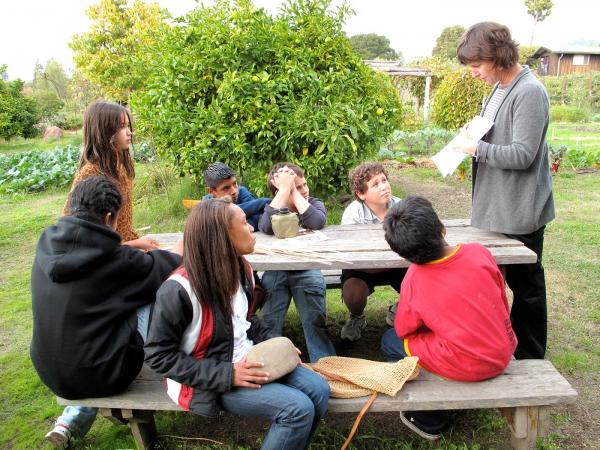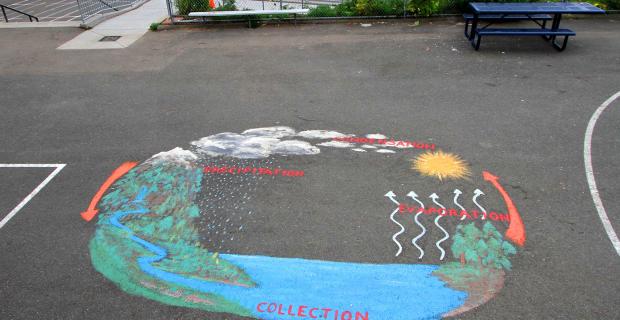What Can Educators Do to Foster Real Intelligence?

What can educators do to foster real intelligence?... We can attempt to teach the things that one might imagine the earth would teach us: silence, humility, holiness, connectedness, courtesy, beauty, celebration, giving, restoration, obligation, and wildness.
— David W. Orr
There is a bold new movement underway in school systems across North America and around the world. Educators, parents, and students are remaking K–12 education to prepare students for the environmental challenges of the coming decades. They are discovering that guidance for living abundantly on a finite planet lies, literally, under their feet and all around them — in living soil, food webs and water cycles, energy from the sun, and everywhere that nature reveals her ways. Smart by Nature schooling draws on 3.8 billion years of natural research and development to find solutions to problems of sustainable living, make teaching and learning more meaningful, and create a more hopeful future from people and communities.
School gardens bloom in wintry climates and on former asphalt lots. Students learn good nutrition while eating healthy lunches of farm-fresh food. At independent schools in New Jersey, public schools in California, and charter schools in Wisconsin, education comes alive as children discover the wonders of nature while restoring rural landscapes, protecting endangered species, and creating city habitats. Classroom buildings in schools on the South Side of Chicago, in central Arkansas, and in suburban Oregon become living laboratories for energy conservation and resource stewardship.
Schools from Washington to Florida have transformed into model communities. Utilities, governments, and educators have become partners in designing energy-efficient, safe, and healthy schools that promote the welfare of students and school staff while teaching wise use of resources and care of the earth. In small towns and large cities, students practice the arts of citizenship while improving the lives of their neighbors.
This movement responds to the realization that the young people in school today will inherit a host of pressing — and escalating — environmental challenges: threats of climate change; loss of biodiversity; the end of cheap energy; depletion of resources; environmental degradation; gross inequities in standards of living; obesity, diabetes, asthma, and other environmentally linked illness. This generation will require leaders and citizens who can think ecologically, understand the interconnectedness of human and natural systems, and have the will, ability, and courage to act.
The movement goes by many names: green schools, eco-schools, high-performance schools. We call it schooling for sustainability to underline its kinship with other global movements reshaping the relationships between human societies and the natural world. At the same time, we acknowledge that the term sustainability is problematic to some people.
"The word 'sustainability' has gotten such a workout lately that the whole concept is in danger of floating away on a sea of inoffensiveness," wrote Michael Pollan in late 2007. "Everybody, it seems, is for it — whatever 'it' means." Paradoxically, many people remain unaware of the concept, while others have already concluded that it is on its way to joining natural and ecological as words that can simultaneously mean anything and nothing. "If a man characterized his relationship with his wife as sustainable," wrote architect William McDonough and chemist Michael Braungart, "you might well pity them both." After reviewing the alternatives, though, writer and consultant Alan AtKisson concluded, "As a name for the future of our dreams, sustainability may be 'the worst word, except for all the others.'" Thinkers and activists whose work we greatly admire use this word. It links to international movements on behalf of human and planetary well-being.
To stay useful, sustainability must mean more than merely surviving or trying to keep a degraded world from getting worse. Otherwise, why bother? Invoking nature's capacity for sustaining life, as Fritjof Capra suggests, is critical. A sustainable community worth imagining is alive, in the most exuberant sense of that word — fresh, vital, evolving, diverse, and dynamic. It cares about the quality as well as the continuation of life. It is flexible and adaptive. It draws energy from its environment, celebrates organic wholeness, and appreciates that life has more to reveal than human cleverness has yet discovered. It teaches its children to pay attention to the world around them, to respect what they cannot control, and to embrace the creativity with which life sustains itself.
Few question the need to prepare students for the complex world into which they will graduate, but the schooling for sustainability movement nevertheless encounters obstacles: School systems are notoriously slow to change. Responsibilities for schools' operations are often dispersed through multiple levels of authority, from the local principal to the federal government, with mandates that sometimes conflict. Virtually all schools and districts face financial challenges. Schooling for sustainability competes with other priorities, including standardized testing in public schools and pressure to focus on Advanced Placement in independent schools.
This book — the fruit of two decades of work by the Center for Ecoliteracy, a public foundation in Berkeley, California, dedicated to education for sustainable living — presents Smart by Nature, the center's framework for schooling for sustainability. It offers inspiration by documenting the accomplishments of many schools, shares the lessons they have learned, and furthers the discussion that has begun among the many parties to this movement.
We report how schools across the country are creatively overcoming barriers. In doing so, they are also discovering that schooling for sustainability is a winning proposition with many direct and indirect benefits. What is good for the future of the environment and for communities is also good for schools and students now. Students who learn nature's principles in gardens and serve their communities through civic participation become more engaged in their studies and score better in diverse subjects, including science, reading and writing, and independent thinking.
Designing buildings to conserve energy and water can save enough money to convince finance-minded school boards. Going green helps competitive independent schools to attract students and local communities to attract residents and business. Students and staff members who eat better meals and spend their days in buildings with better air quality are absent less often, report higher satisfaction, and perform better. Schools become better appreciated as assets to their communities.
Schooling for sustainability is a constantly evolving process. It takes place in schools that use the woods outside their classrooms as their playgrounds and laboratories, on campuses set on inner city asphalt lots, and in schools dropped into the middle of suburban housing tracts. It takes place in schools with innovative lunch programs served in aging buildings and in schools with brand-new facilities and no lunch service at all. Our research has discovered sustainability projects initiated by superintendents and heads of school, by individual faculty members, by students, and by handfuls of parents. We have found efforts headed by paid sustainability officers and thriving projects led by informal ecology clubs with no budgets.
This book explores four broad topic areas of schooling for sustainability — food, the campus, community, and teaching and learning — from the perspective of the Smart by Nature guiding principles. Each chapter includes profiles of schools or districts that have creatively addressed these topics, and the strategies they have employed to overcome obstacles, create change within institutions, and incorporate schooling for sustainability into curricula.
The examples used throughout were chosen in order to present a range of experiences and approaches, applied in a variety of school types and geographical regions. Many other exemplary schools and programs could have been included. We plan to continue chronicling schooling for sustainability in future publications and on this website, and invite readers to become part of our ongoing collaboration and to share their experiences in the SHARE section of the site.
This essay is adapted from the introduction to Smart by Nature: Schooling for Sustainability (Watershed Media/University of California Press, 2009).




